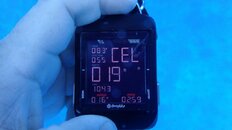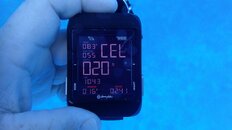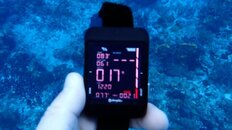It's less aggressive than an Oceanic computer using the DSAT algorithm.
It depends on profile and depth to be honest. I typically run a Shearwater alongside an Oceanic with DSAT. Just not on this trip. In general though yes, I find DSAT to be more aggressive/liberal.
In some cases Shearwater will give more time than Oceanic depending on your depth, sometimes even ascending 10ft (3.3m) makes a huge difference. Not so much on square profile. Obviously not always a good idea to ride this.. I should have taken some pictures for comparison.
On this trip the DeepBlu Cosmiq ran out of time and went into deco much sooner than Shearwater. Unfortunately I don't know what the DeepBlu Cosmiq's conservative settings correspond to so it's hard to quantify. According to their documention, the decompression algorithm is based on the Bühlmann ZH-L16C model. Not sure what they have done to modify it or what they might use for gradient factors.
I relatively recently bought a Dive Rite Nitek Q, mainly to gain experience with Buhlmann ZH-L16C. My primary computer is an Oceanic VT3, pre-dual algorithm, runs only DSAT. I have been diving Oceanic computers running DSAT since 2002, a little over 1150 dives. As
@stuartv implies, DSAT is in the aggressive end of the spectrum
As
@macado points out, the comparison between DSAT and ZHL is depth dependent, it is also somewhat EAN mix dependent. At relatively shallower depths, 70-80 feet, a GF hi of 95 is the best match for DSAT NDLs. Below this, a GF hi of 100 is the best match for DSAT NDLs. Obviously, GF lo does not kick in until you exceed NDL and go into deco.
I have also been interested in the Deepblu proprietary Buhlmann variant. Oceanic's PZ+ is another example of a proprietary Buhlmann variant. The details of either of these are not in the public domain. The Deepblu "normal" conservative factor algorithm is obviously quite conservative and NDLs from the planning mode have been posted on SB. After bugging them on numerous occasions, Deepblue sent me an evaluation of their computer using the ScubaLab repetitive dive, hyperbaric chamber test. As this information is not otherwise in the public domain, I am uncomfortable in posting it. If Deepblu wants this information to be disseminated, they will make it available or fulfill others requests for it. Suffice it to say that the "progressive" conservative factor algorithm increases NDLs, but appears to remain middle of the road and more conservative than DSAT. From the chamber results, it is difficult to compare to PZ+, some more conservative, some more liberal.
In general, increased transparency with regard to computer performance would benefit us all. I'm not holding my breath, so to speak, for this to happen.







